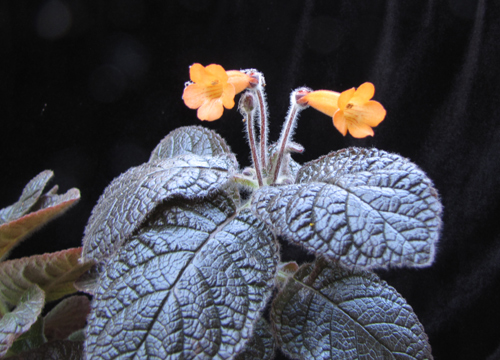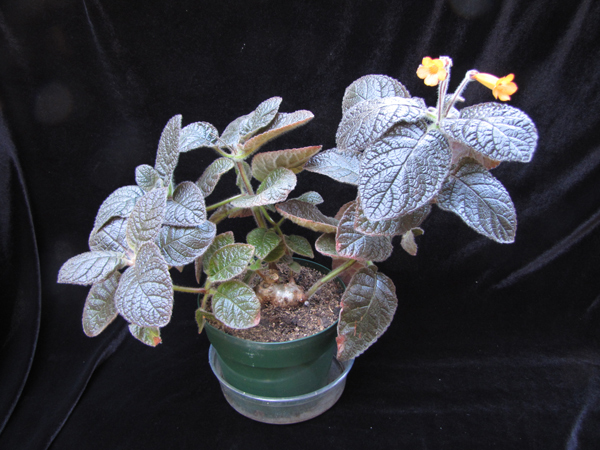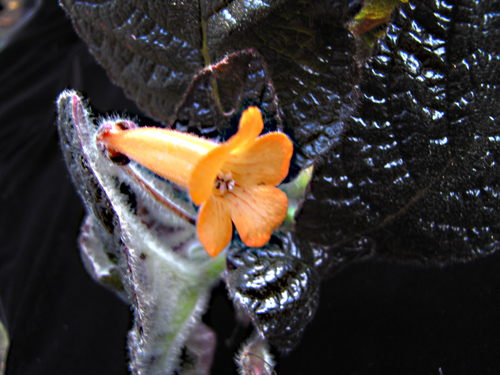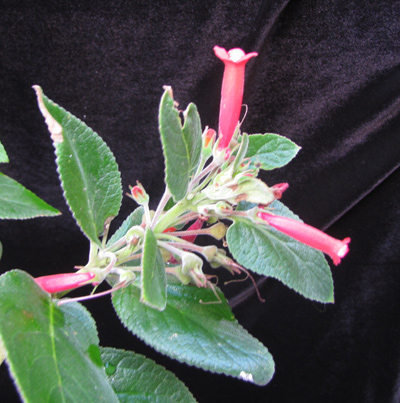Sinningia 'Hermit'
Sinningia 'Hermit' is a hybrid created by Jim Steuerlein of Florida. It has striking dark foliage and contrasting true-orange flowers.

| Species list |
Hybrids list |
Tubers list |
Topics list |
Site index |
What's new |
Home page |
Sinningia 'Hermit'Sinningia 'Hermit' is a hybrid created by Jim Steuerlein of Florida. It has striking dark foliage and contrasting true-orange flowers. |

|
|
|
|
Description |
|

|
This hybrid bears a lot of resemblance to its pollen parent Sinningia bullata. It has the same quilted foliage and the same branching habit. S. 'Hermit' has also inherited the tendency to bloom off and on throughout the year, instead of at just a single season. The most important differences are in color. If the plant is given sufficient sunlight, the foliage will be almost black. This makes a very dramatic contrast with the flowers, which are a pure orange. |
|
The only real drawback to the plant is its floriferousness, or rather, lack of it. It has relatively few flowers at a time -- both Jim and I have observed this. This is not something one would have expected from is ancestry. The unusual color and contrast with foliage counterbalances that shortcoming. For best foliage color, the plant should be grown in full sun. |
|
OrangeSome people use the word orange for all flowers not on the purple side of red. To me, Sinningia bullata has red flowers. Whatever. Sinningia 'Hermit' has orange flowers. |

|
Comparison |
||
| Trait | Hermit | S. bullata |
|---|---|---|
| Habit | Freely branching, lots of foliage | Freely branching, some bare stems |
| Leaves | Quilted, black | Quilted, light green |
| Hairiness | Some on leaf reverse | Intensely hairy on stems and leaf reverses, especially new ones. |
| Corolla | Orange, tubular, 3.7 cm long | Orange-red, tubular, 3.7 cm long |
AncestryThe pollen parent of S. 'Hermit' was Sinningia bullata. The hybrid has inherited many features from this ancestor. The seed parent of S. 'Hermit' was itself a complex hybrid involving four species. One parent was Jim's cross S. macrostachya x "Black Hill". A section of this plant is shown at the right. (I think of it as stack black.) The other parent was Jim's cross S. conspicua x polyantha. A picture of its flower can be seen here. It will be observed that the four species which go into the seed parent hybrid have little visible effect on the appearance of S. 'Hermit'. Jim reports that most of the siblings of 'Hermit' have normal green foliage. This underscores that plant pigments aren't like mixing paint. Red + blue does not always equal purple. White + red does not always come out pink. The pigments are the product of a chain of synthetic reactions, and a modification of just one of those reactions will alter the final product in ways that are not intuitive. The colors we see depend on what light the plant reflects. That depends not only on the chemical structure of all the pigments in the leaf, but also their electrical structure. So we should not be surprised when we get unexpected results. In hybridizing, unexpected is sometimes good. |

Stack Black |
| Plant Description |
|
| Growth | Indeterminate |
| Habit | Small shrub, freely branching with age, much like S. bullata. |
| Leaves | Quilted foliage like that of S. bullata, but very dark, almost black. |
| Dormancy | Has a tuber, but has not gone dormant under my conditions |
Flowering |
|
| Inflorescence | Axillary cymes, usually 1-2 flowers per axil. |
| Flowering | Periodic throughout the year |
| Flower | Pure orange, similar in shape to that of S. bullata. |
Horticultural aspects |
|
| Hardiness | Approximately the same as S. bullata |
| Propagation | Cuttings are slow to root. In this way it resembles S. bullata |
| Recommended? | Definitely. Attractive plant. Culture seems to be easy so far. |
Hybridization |
|
| Hybridizer | Jim Steuerlein |
| Fertility | No reason it should not be fertile. |